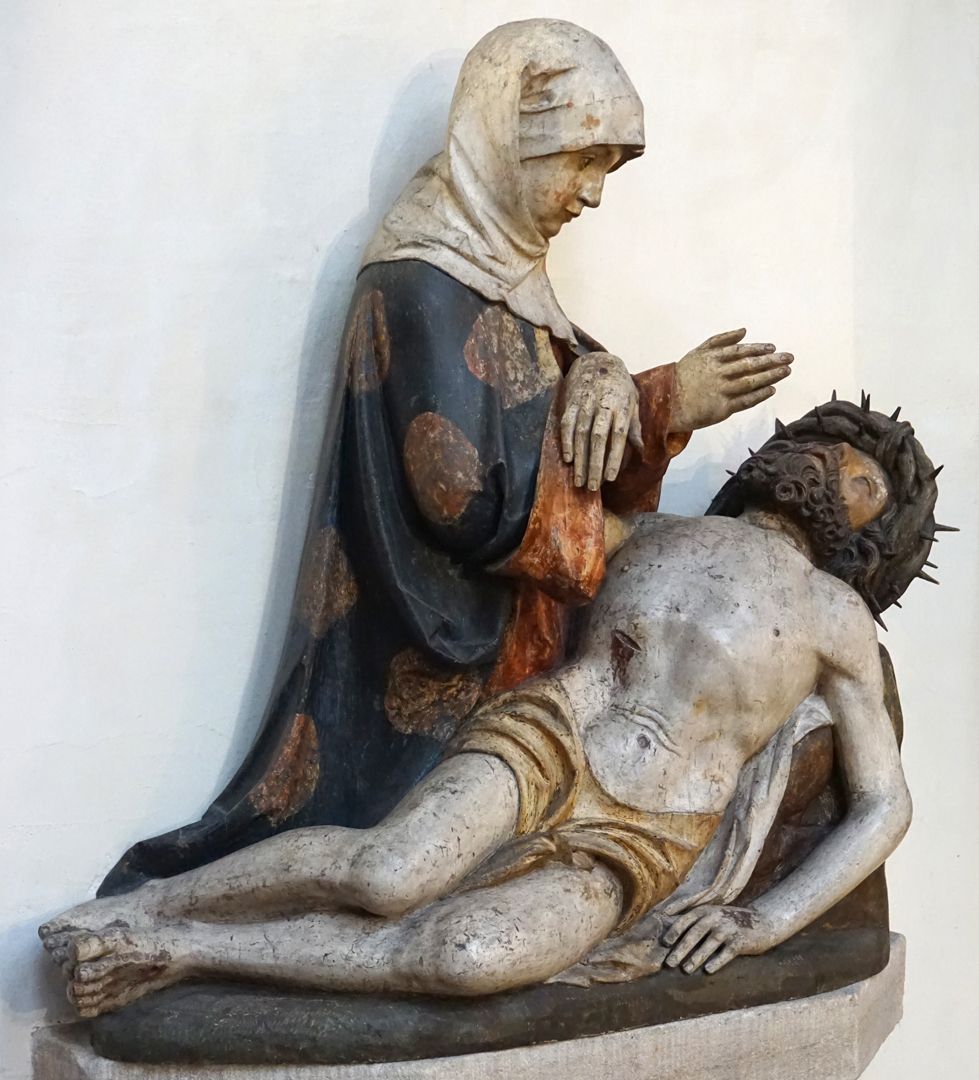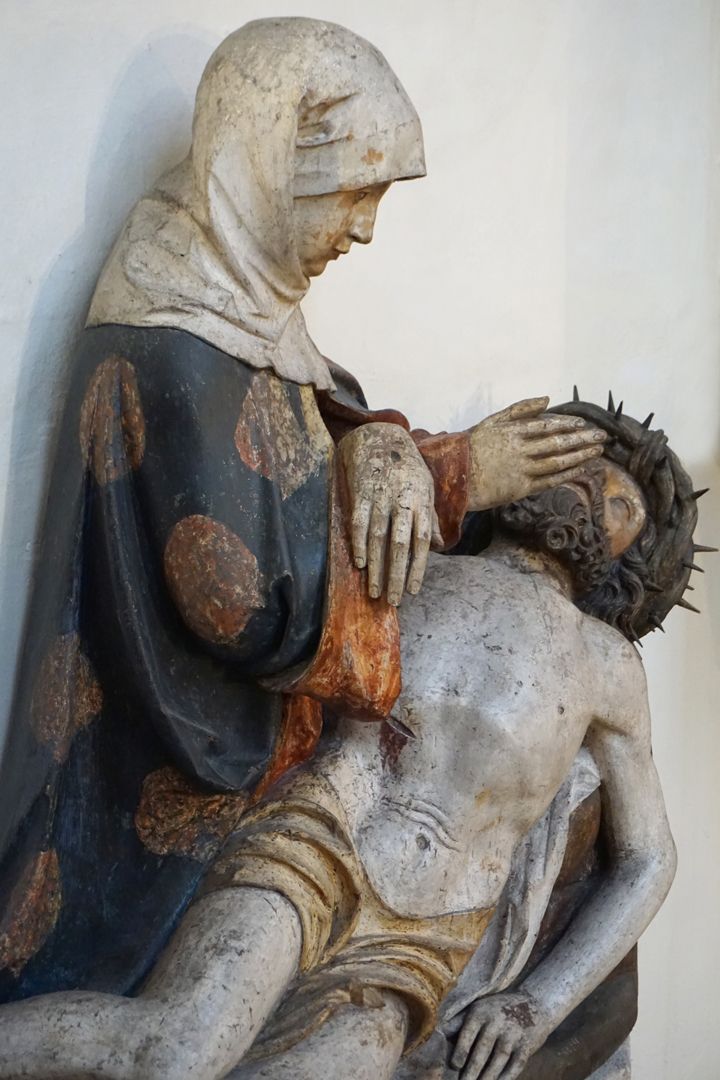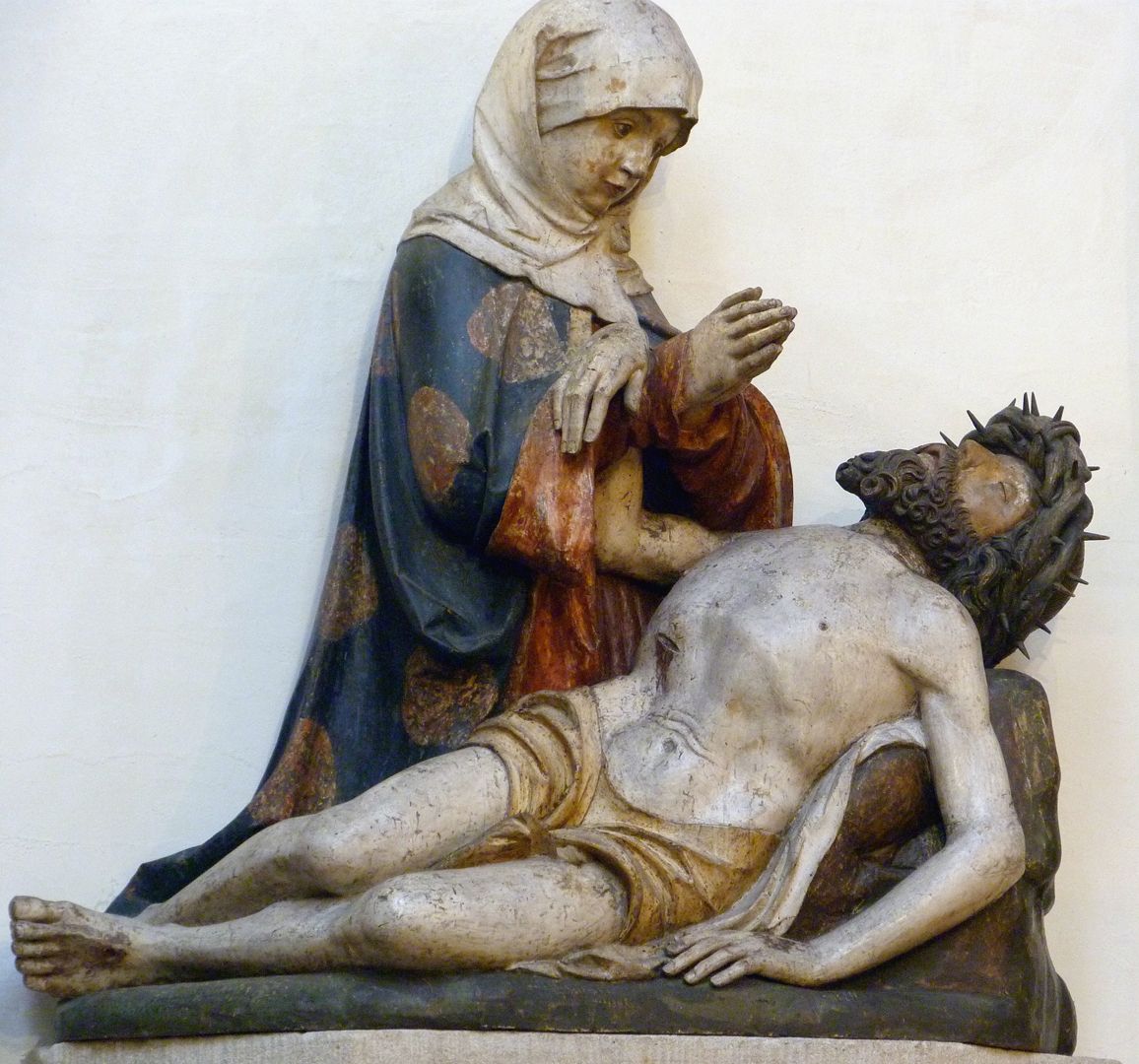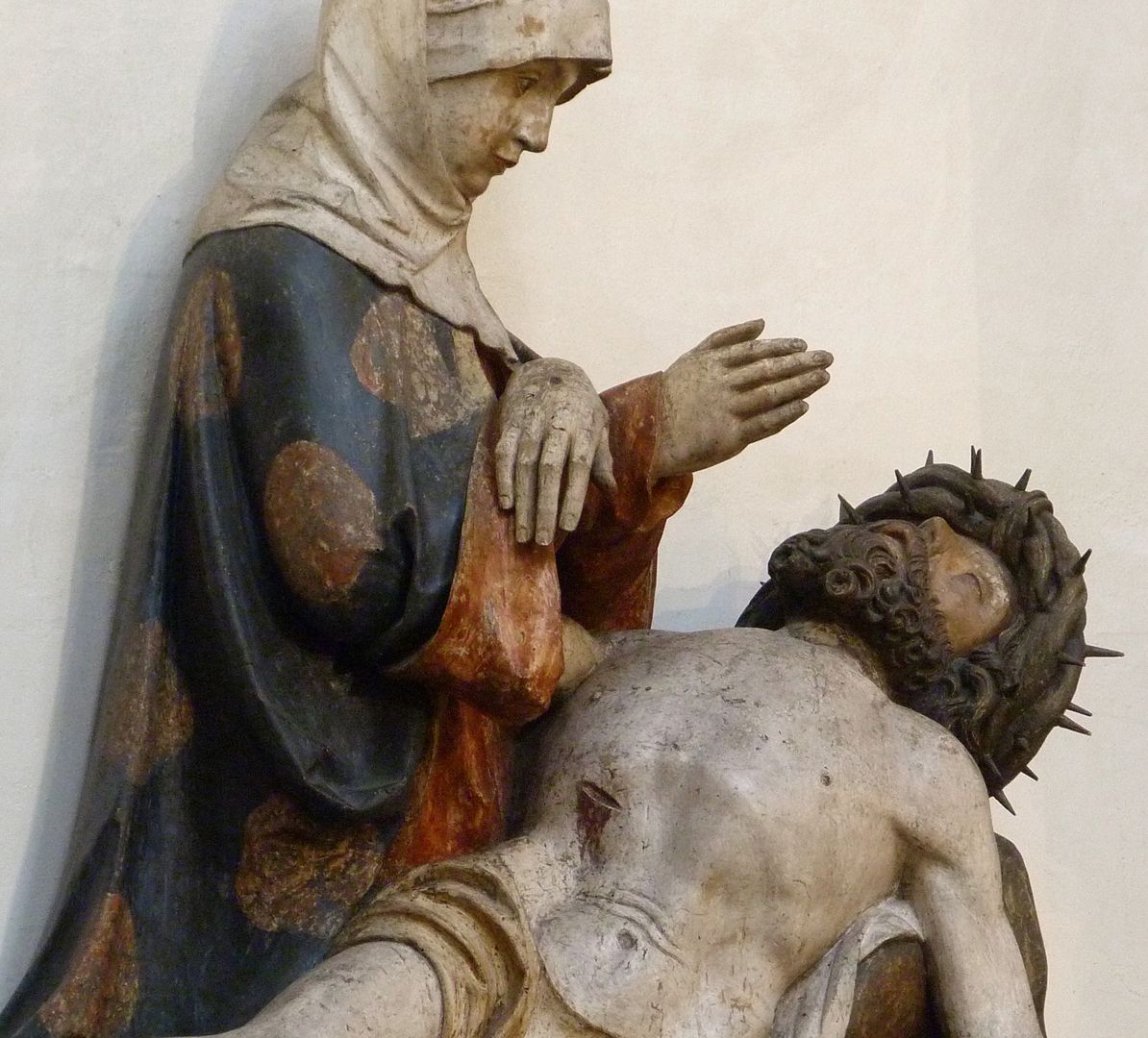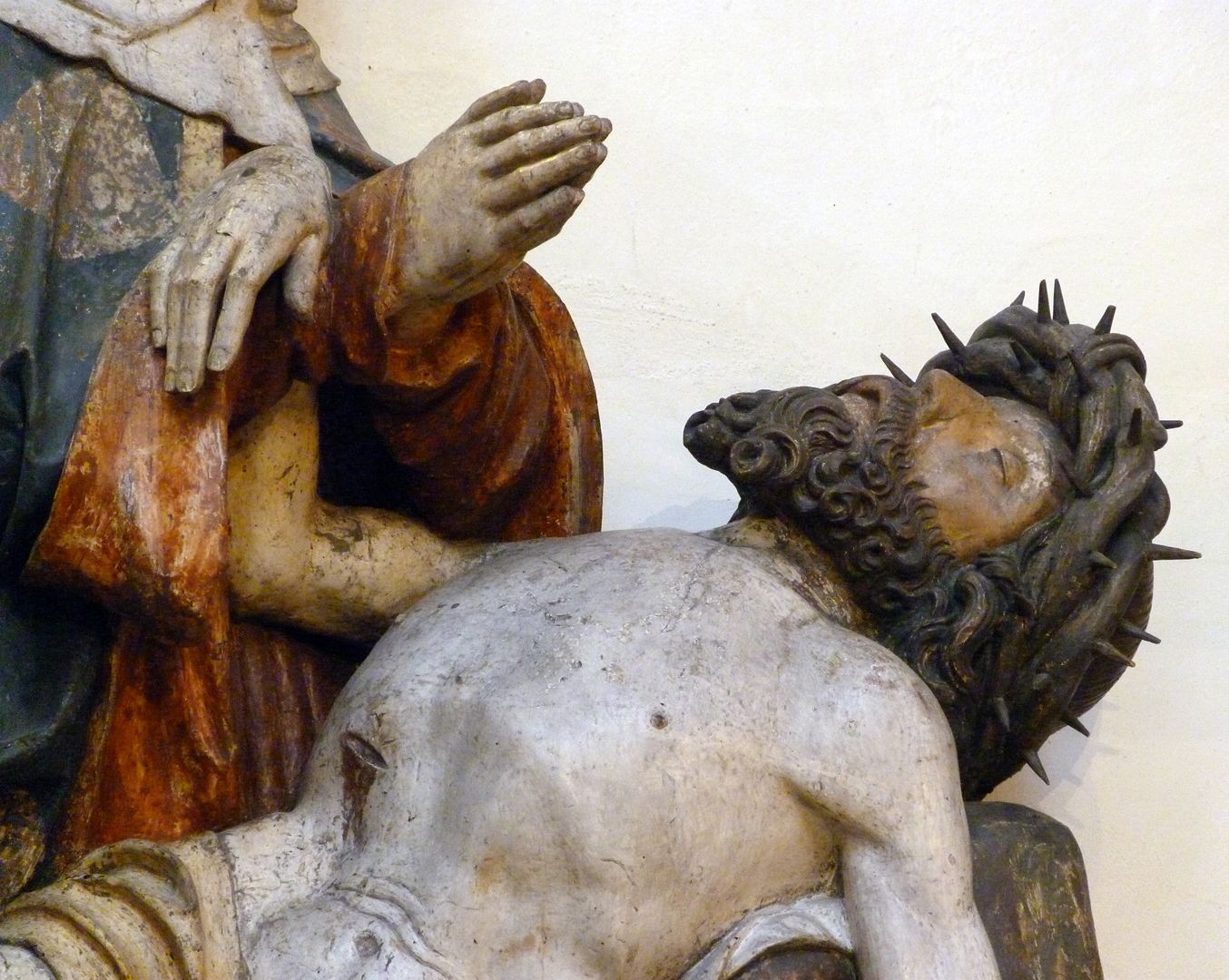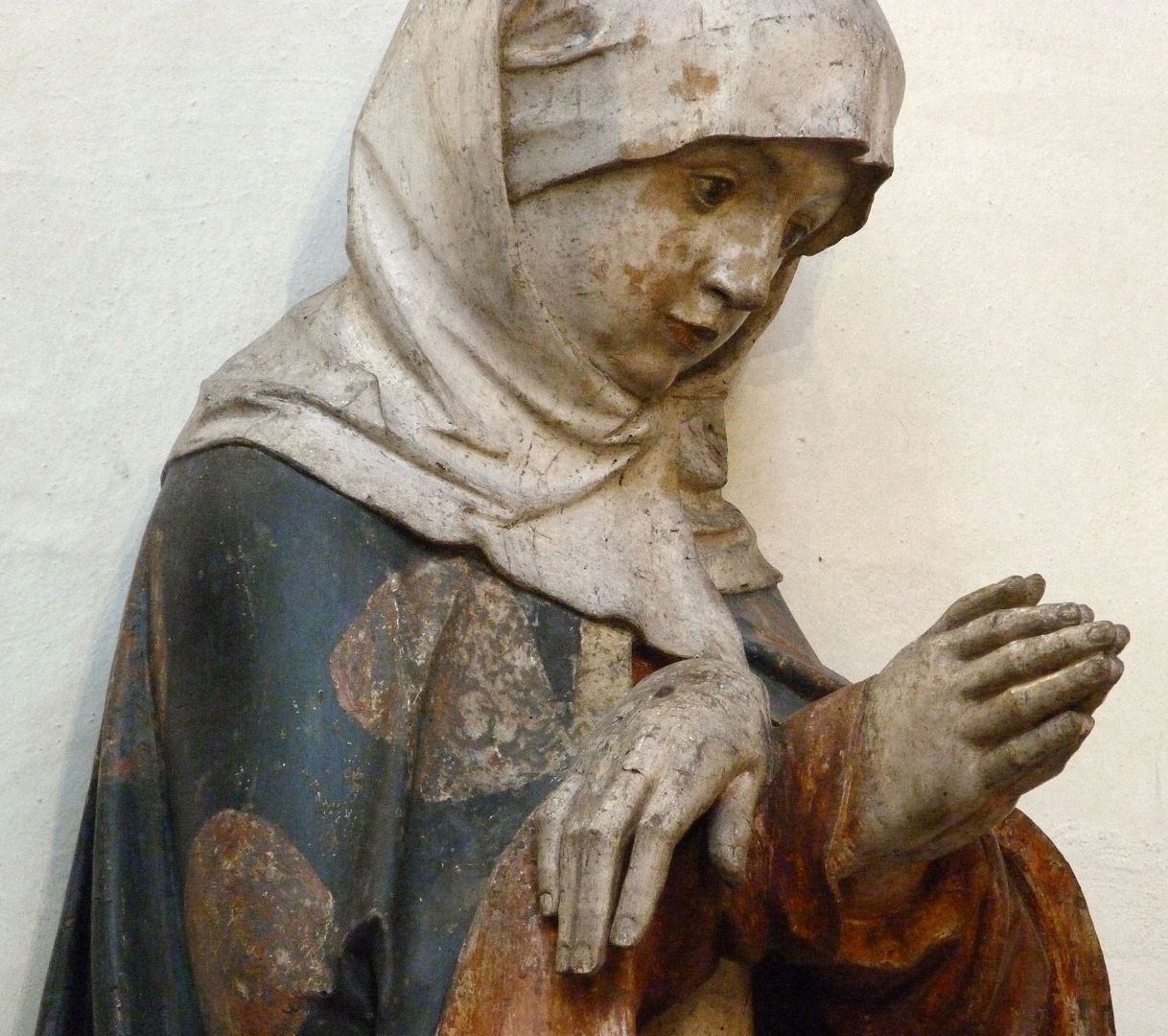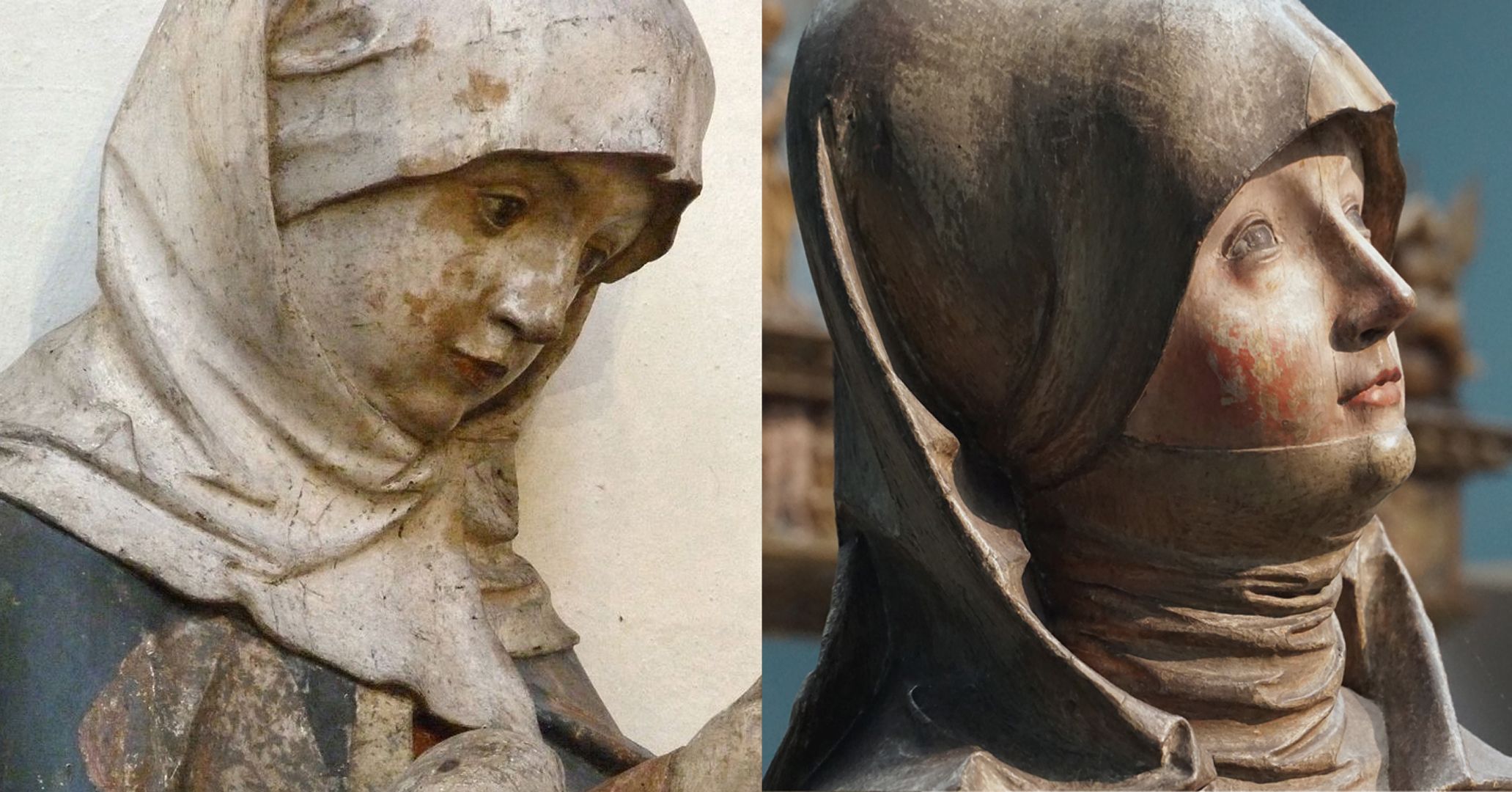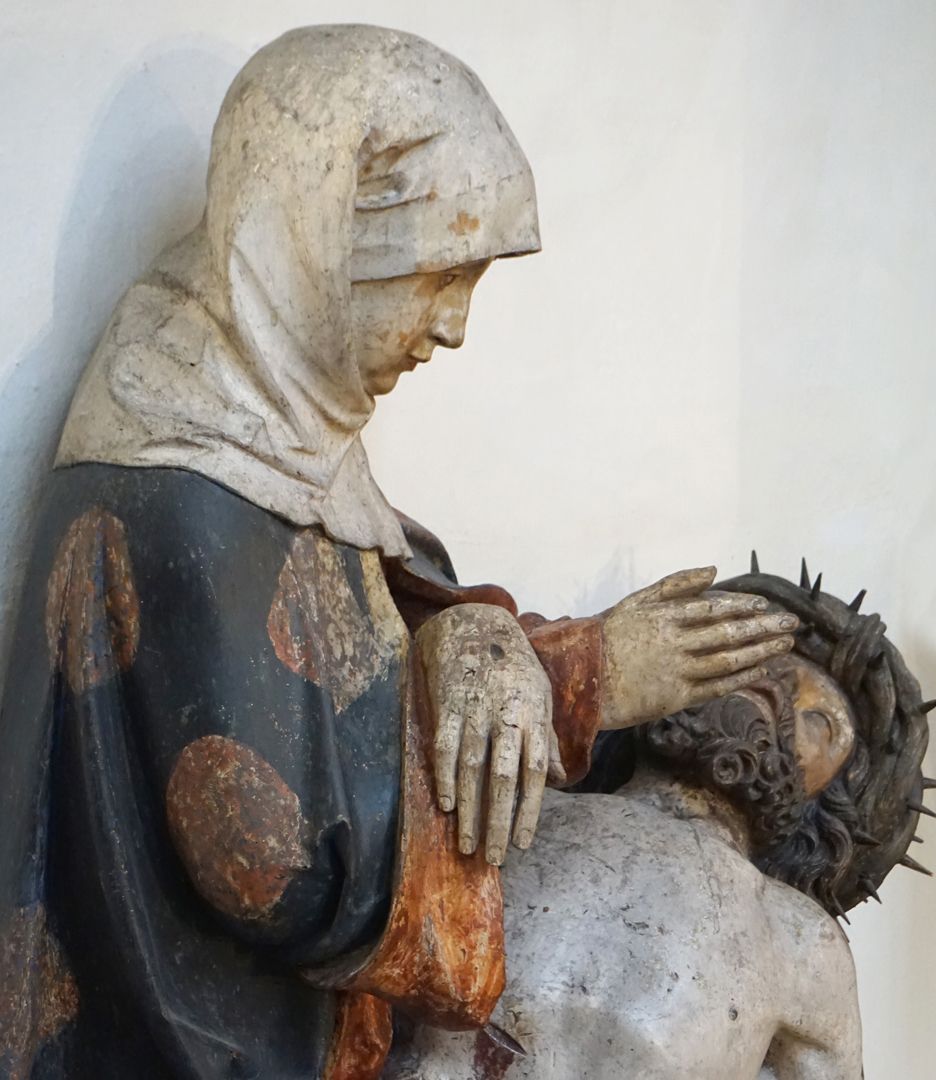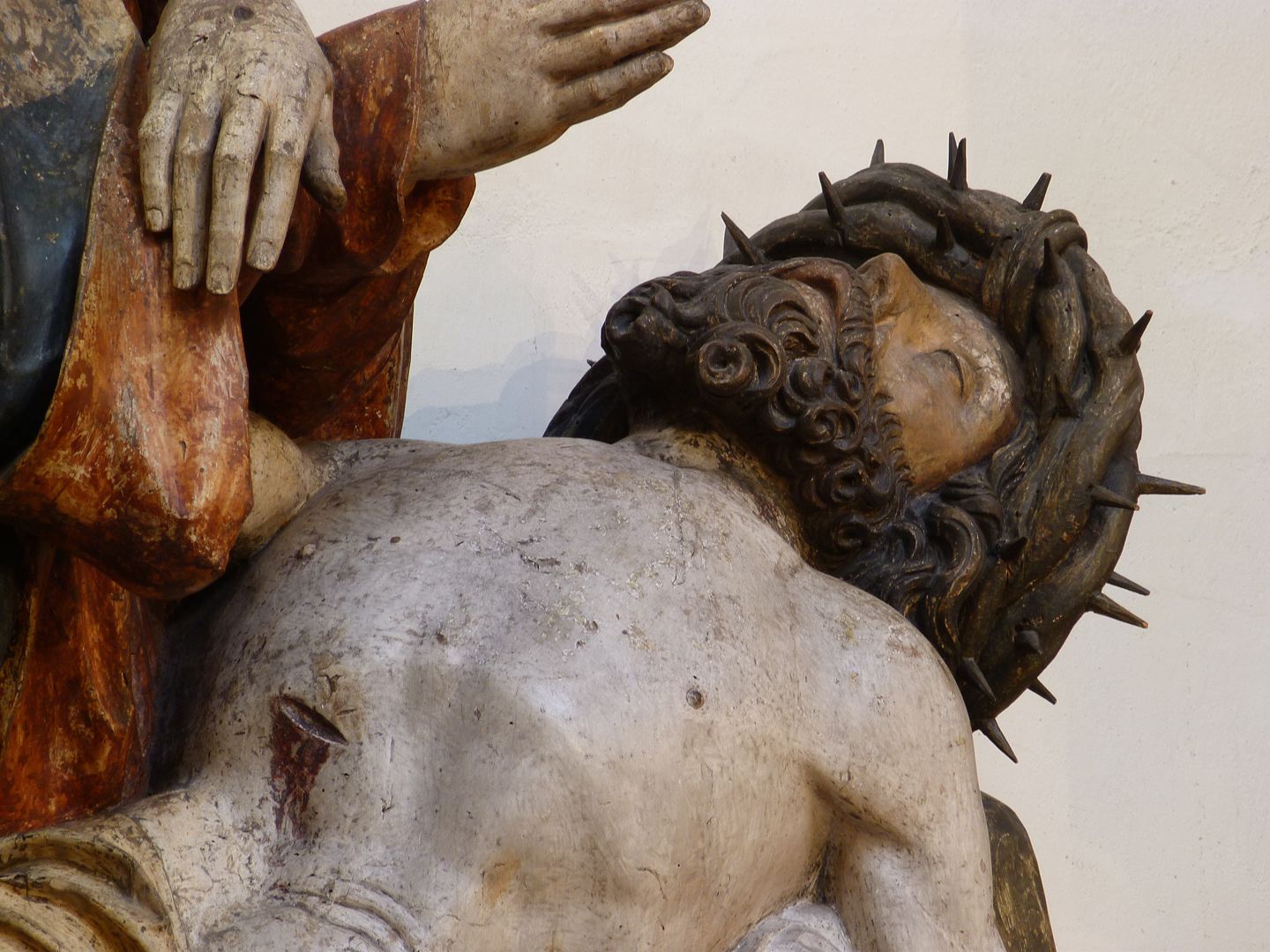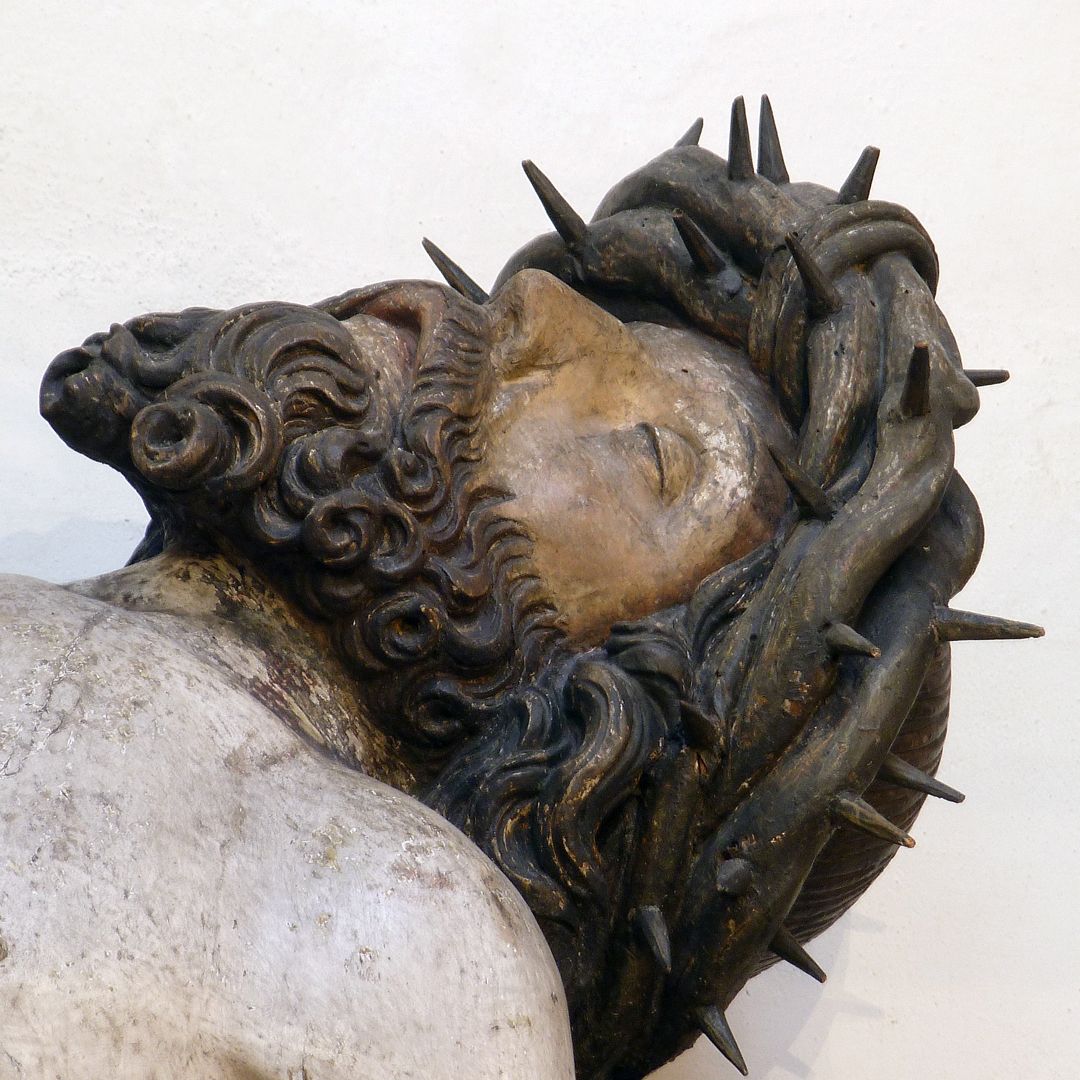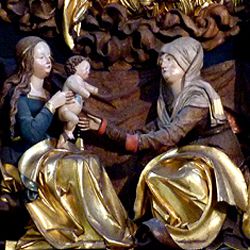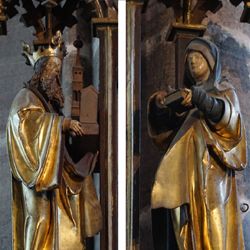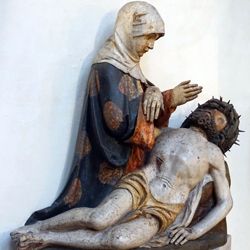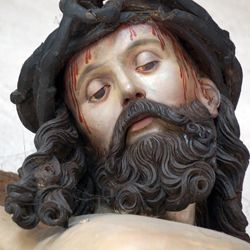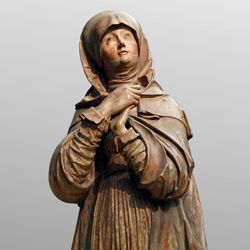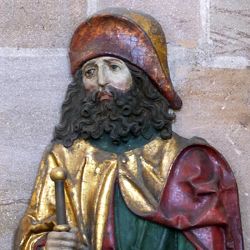Little Pietà
Little Pietà
around 1512
Main view
Master Jörg and workshop
The so-called Small Pietà on the chancel wall of Nuremberg's Jakobskirche is undoubtedly one of the highest-quality sculptural creations of the Dürer period. This graceful devotional picture, filled with great tranquillity, was probably donated in 1512 by Hans or his brother Johannes Murr to its present location to the left of the Sacrament House and must be seen in the context of the figures discussed so far.
The Mother of God, portrayed girlishly and without signs of grief, turns adoringly to the right towards the face of her dead Son. His corpse rests on a sheet with his legs bent and his upper body leaning slightly upright against a stone formation, so that the viewer is artistically given a reverent view of all the stigmata of the Saviour. His head with the crown of thorns falls limply backwards. While his left arm sinks bent to the ground, the other leads upwards and the hand lies in an elegiac gesture over Mary's right forearm. The harmony of the group, whose actual main view from the left is entirely focused on its location, the elegance of the forms and movements, the mixture of observation of nature and formal simplification unmistakably refers to the Jobster Crucifix. Both works also bear witness to an identical sculptural sensibility in their physicality. The two-dimensional design of Mary's veil with the few thin fold ridges that split open, which are also typical of Jesus' loincloth, or the small-worldly movement of the hem of the veil are part of the proven repertoire of forms in Master Jörg's carving workshop". (Stefan Roller, Hans von Kulmbach und der Nürnberger Bildschnitzer Meister Jörg, in: Renaissance in Franken. Hans von Kulmbach and the Art around Dürer, 2022, pp.118 -119)
Location: Nuremberg, St. James´Church (St. Jakob)
Design: Herb (Meister Jörg Pildschnitzer), Georg
Realization: Herb (Meister Jörg Pildschnitzer), Georg
photo 2020, Theo Noll
Little Pietà
around 1512
Detailed view
Master Jörg and workshop
The so-called Small Pietà on the chancel wall of Nuremberg's Jakobskirche is undoubtedly one of the highest-quality sculptural creations of the Dürer period. This graceful devotional picture, filled with great tranquillity, was probably donated in 1512 by Hans or his brother Johannes Murr to its present location to the left of the Sacrament House and must be seen in the context of the figures discussed so far.
The Mother of God, portrayed girlishly and without signs of grief, turns adoringly to the right towards the face of her dead Son. His corpse rests on a sheet with his legs bent and his upper body leaning slightly upright against a stone formation, so that the viewer is artistically given a reverent view of all the stigmata of the Saviour. His head with the crown of thorns falls limply backwards. While his left arm sinks bent to the ground, the other leads upwards and the hand lies in an elegiac gesture over Mary's right forearm. The harmony of the group, whose actual main view from the left is entirely focused on its location, the elegance of the forms and movements, the mixture of observation of nature and formal simplification unmistakably refers to the Jobster Crucifix. Both works also bear witness to an identical sculptural sensibility in their physicality. The two-dimensional design of Mary's veil with the few thin fold ridges that split open, which are also typical of Jesus' loincloth, or the small-worldly movement of the hem of the veil are part of the proven repertoire of forms in Master Jörg's carving workshop". (Stefan Roller, Hans von Kulmbach und der Nürnberger Bildschnitzer Meister Jörg, in: Renaissance in Franken. Hans von Kulmbach and the Art around Dürer, 2022, pp.118 -119)
Location: Nuremberg, St. James´Church (St. Jakob)
Design: Herb (Meister Jörg Pildschnitzer), Georg
Realization: Herb (Meister Jörg Pildschnitzer), Georg
photo 2020, Theo Noll
Little Pietà
around 1512
Master Jörg and workshop
The so-called Small Pietà on the chancel wall of Nuremberg's Jakobskirche is undoubtedly one of the highest-quality sculptural creations of the Dürer period. This graceful devotional picture, filled with great tranquillity, was probably donated in 1512 by Hans or his brother Johannes Murr to its present location to the left of the Sacrament House and must be seen in the context of the figures discussed so far.
The Mother of God, portrayed girlishly and without signs of grief, turns adoringly to the right towards the face of her dead Son. His corpse rests on a sheet with his legs bent and his upper body leaning slightly upright against a stone formation, so that the viewer is artistically given a reverent view of all the stigmata of the Saviour. His head with the crown of thorns falls limply backwards. While his left arm sinks bent to the ground, the other leads upwards and the hand lies in an elegiac gesture over Mary's right forearm. The harmony of the group, whose actual main view from the left is entirely focused on its location, the elegance of the forms and movements, the mixture of observation of nature and formal simplification unmistakably refers to the Jobster Crucifix. Both works also bear witness to an identical sculptural sensibility in their physicality. The two-dimensional design of Mary's veil with the few thin fold ridges that split open, which are also typical of Jesus' loincloth, or the small-worldly movement of the hem of the veil are part of the proven repertoire of forms in Master Jörg's carving workshop". (Stefan Roller, Hans von Kulmbach und der Nürnberger Bildschnitzer Meister Jörg, in: Renaissance in Franken. Hans von Kulmbach and the Art around Dürer, 2022, pp.118 -119)
Location: Nuremberg, St. James´Church (St. Jakob)
Design: Herb (Meister Jörg Pildschnitzer), Georg
Realization: Herb (Meister Jörg Pildschnitzer), Georg
photo 2020, Theo Noll
Little Pietà
around 1512
Detailed view
Master Jörg and workshop
The so-called Small Pietà on the chancel wall of Nuremberg's Jakobskirche is undoubtedly one of the highest-quality sculptural creations of the Dürer period. This graceful devotional picture, filled with great tranquillity, was probably donated in 1512 by Hans or his brother Johannes Murr to its present location to the left of the Sacrament House and must be seen in the context of the figures discussed so far.
The Mother of God, portrayed girlishly and without signs of grief, turns adoringly to the right towards the face of her dead Son. His corpse rests on a sheet with his legs bent and his upper body leaning slightly upright against a stone formation, so that the viewer is artistically given a reverent view of all the stigmata of the Saviour. His head with the crown of thorns falls limply backwards. While his left arm sinks bent to the ground, the other leads upwards and the hand lies in an elegiac gesture over Mary's right forearm. The harmony of the group, whose actual main view from the left is entirely focused on its location, the elegance of the forms and movements, the mixture of observation of nature and formal simplification unmistakably refers to the Jobster Crucifix. Both works also bear witness to an identical sculptural sensibility in their physicality. The two-dimensional design of Mary's veil with the few thin fold ridges that split open, which are also typical of Jesus' loincloth, or the small-worldly movement of the hem of the veil are part of the proven repertoire of forms in Master Jörg's carving workshop". (Stefan Roller, Hans von Kulmbach und der Nürnberger Bildschnitzer Meister Jörg, in: Renaissance in Franken. Hans von Kulmbach and the Art around Dürer, 2022, pp.118 -119)
Location: Nuremberg, St. James´Church (St. Jakob)
Design: Herb (Meister Jörg Pildschnitzer), Georg
Realization: Herb (Meister Jörg Pildschnitzer), Georg
photo 2020, Theo Noll
Little Pietà
around 1512
Detailed view
Master Jörg and workshop
The so-called Small Pietà on the chancel wall of Nuremberg's Jakobskirche is undoubtedly one of the highest-quality sculptural creations of the Dürer period. This graceful devotional picture, filled with great tranquillity, was probably donated in 1512 by Hans or his brother Johannes Murr to its present location to the left of the Sacrament House and must be seen in the context of the figures discussed so far.
The Mother of God, portrayed girlishly and without signs of grief, turns adoringly to the right towards the face of her dead Son. His corpse rests on a sheet with his legs bent and his upper body leaning slightly upright against a stone formation, so that the viewer is artistically given a reverent view of all the stigmata of the Saviour. His head with the crown of thorns falls limply backwards. While his left arm sinks bent to the ground, the other leads upwards and the hand lies in an elegiac gesture over Mary's right forearm. The harmony of the group, whose actual main view from the left is entirely focused on its location, the elegance of the forms and movements, the mixture of observation of nature and formal simplification unmistakably refers to the Jobster Crucifix. Both works also bear witness to an identical sculptural sensibility in their physicality. The two-dimensional design of Mary's veil with the few thin fold ridges that split open, which are also typical of Jesus' loincloth, or the small-worldly movement of the hem of the veil are part of the proven repertoire of forms in Master Jörg's carving workshop". (Stefan Roller, Hans von Kulmbach und der Nürnberger Bildschnitzer Meister Jörg, in: Renaissance in Franken. Hans von Kulmbach and the Art around Dürer, 2022, pp.118 -119)
Location: Nuremberg, St. James´Church (St. Jakob)
Design: Herb (Meister Jörg Pildschnitzer), Georg
Realization: Herb (Meister Jörg Pildschnitzer), Georg
photo 2020, Theo Noll
Little Pietà
around 1512
Detailed view
Master Jörg and workshop
The so-called Small Pietà on the chancel wall of Nuremberg's Jakobskirche is undoubtedly one of the highest-quality sculptural creations of the Dürer period. This graceful devotional picture, filled with great tranquillity, was probably donated in 1512 by Hans or his brother Johannes Murr to its present location to the left of the Sacrament House and must be seen in the context of the figures discussed so far.
The Mother of God, portrayed girlishly and without signs of grief, turns adoringly to the right towards the face of her dead Son. His corpse rests on a sheet with his legs bent and his upper body leaning slightly upright against a stone formation, so that the viewer is artistically given a reverent view of all the stigmata of the Saviour. His head with the crown of thorns falls limply backwards. While his left arm sinks bent to the ground, the other leads upwards and the hand lies in an elegiac gesture over Mary's right forearm. The harmony of the group, whose actual main view from the left is entirely focused on its location, the elegance of the forms and movements, the mixture of observation of nature and formal simplification unmistakably refers to the Jobster Crucifix. Both works also bear witness to an identical sculptural sensibility in their physicality. The two-dimensional design of Mary's veil with the few thin fold ridges that split open, which are also typical of Jesus' loincloth, or the small-worldly movement of the hem of the veil are part of the proven repertoire of forms in Master Jörg's carving workshop". (Stefan Roller, Hans von Kulmbach und der Nürnberger Bildschnitzer Meister Jörg, in: Renaissance in Franken. Hans von Kulmbach and the Art around Dürer, 2022, pp.118 -119)
Location: Nuremberg, St. James´Church (St. Jakob)
Design: Herb (Meister Jörg Pildschnitzer), Georg
Realization: Herb (Meister Jörg Pildschnitzer), Georg
photo 2020, Theo Noll
Little Pietà
around 1512
Image comparison: left Maria, LittlePietà / right so-called Nuremberg Madonna
Master Jörg and workshop
The so-called Small Pietà on the chancel wall of Nuremberg's Jakobskirche is undoubtedly one of the highest-quality sculptural creations of the Dürer period. This graceful devotional picture, filled with great tranquillity, was probably donated in 1512 by Hans or his brother Johannes Murr to its present location to the left of the Sacrament House and must be seen in the context of the figures discussed so far.
The Mother of God, portrayed girlishly and without signs of grief, turns adoringly to the right towards the face of her dead Son. His corpse rests on a sheet with his legs bent and his upper body leaning slightly upright against a stone formation, so that the viewer is artistically given a reverent view of all the stigmata of the Saviour. His head with the crown of thorns falls limply backwards. While his left arm sinks bent to the ground, the other leads upwards and the hand lies in an elegiac gesture over Mary's right forearm. The harmony of the group, whose actual main view from the left is entirely focused on its location, the elegance of the forms and movements, the mixture of observation of nature and formal simplification unmistakably refers to the Jobster Crucifix. Both works also bear witness to an identical sculptural sensibility in their physicality. The two-dimensional design of Mary's veil with the few thin fold ridges that split open, which are also typical of Jesus' loincloth, or the small-worldly movement of the hem of the veil are part of the proven repertoire of forms in Master Jörg's carving workshop". (Stefan Roller, Hans von Kulmbach und der Nürnberger Bildschnitzer Meister Jörg, in: Renaissance in Franken. Hans von Kulmbach and the Art around Dürer, 2022, pp.118 -119)
Location: Nuremberg, St. James´Church (St. Jakob)
Design: Herb (Meister Jörg Pildschnitzer), Georg
Realization: Herb (Meister Jörg Pildschnitzer), Georg
photo 2022, Theo Noll
Little Pietà
around 1512
Detailed view
Master Jörg and workshop
The so-called Small Pietà on the chancel wall of Nuremberg's Jakobskirche is undoubtedly one of the highest-quality sculptural creations of the Dürer period. This graceful devotional picture, filled with great tranquillity, was probably donated in 1512 by Hans or his brother Johannes Murr to its present location to the left of the Sacrament House and must be seen in the context of the figures discussed so far.
The Mother of God, portrayed girlishly and without signs of grief, turns adoringly to the right towards the face of her dead Son. His corpse rests on a sheet with his legs bent and his upper body leaning slightly upright against a stone formation, so that the viewer is artistically given a reverent view of all the stigmata of the Saviour. His head with the crown of thorns falls limply backwards. While his left arm sinks bent to the ground, the other leads upwards and the hand lies in an elegiac gesture over Mary's right forearm. The harmony of the group, whose actual main view from the left is entirely focused on its location, the elegance of the forms and movements, the mixture of observation of nature and formal simplification unmistakably refers to the Jobster Crucifix. Both works also bear witness to an identical sculptural sensibility in their physicality. The two-dimensional design of Mary's veil with the few thin fold ridges that split open, which are also typical of Jesus' loincloth, or the small-worldly movement of the hem of the veil are part of the proven repertoire of forms in Master Jörg's carving workshop". (Stefan Roller, Hans von Kulmbach und der Nürnberger Bildschnitzer Meister Jörg, in: Renaissance in Franken. Hans von Kulmbach and the Art around Dürer, 2022, pp.118 -119)
Location: Nuremberg, St. James´Church (St. Jakob)
Design: Herb (Meister Jörg Pildschnitzer), Georg
Realization: Herb (Meister Jörg Pildschnitzer), Georg
photo 2020, Theo Noll
Little Pietà
around 1512
Detailed view
Master Jörg and workshop
The so-called Small Pietà on the chancel wall of Nuremberg's Jakobskirche is undoubtedly one of the highest-quality sculptural creations of the Dürer period. This graceful devotional picture, filled with great tranquillity, was probably donated in 1512 by Hans or his brother Johannes Murr to its present location to the left of the Sacrament House and must be seen in the context of the figures discussed so far.
The Mother of God, portrayed girlishly and without signs of grief, turns adoringly to the right towards the face of her dead Son. His corpse rests on a sheet with his legs bent and his upper body leaning slightly upright against a stone formation, so that the viewer is artistically given a reverent view of all the stigmata of the Saviour. His head with the crown of thorns falls limply backwards. While his left arm sinks bent to the ground, the other leads upwards and the hand lies in an elegiac gesture over Mary's right forearm. The harmony of the group, whose actual main view from the left is entirely focused on its location, the elegance of the forms and movements, the mixture of observation of nature and formal simplification unmistakably refers to the Jobster Crucifix. Both works also bear witness to an identical sculptural sensibility in their physicality. The two-dimensional design of Mary's veil with the few thin fold ridges that split open, which are also typical of Jesus' loincloth, or the small-worldly movement of the hem of the veil are part of the proven repertoire of forms in Master Jörg's carving workshop". (Stefan Roller, Hans von Kulmbach und der Nürnberger Bildschnitzer Meister Jörg, in: Renaissance in Franken. Hans von Kulmbach and the Art around Dürer, 2022, pp.118 -119)
Location: Nuremberg, St. James´Church (St. Jakob)
Design: Herb (Meister Jörg Pildschnitzer), Georg
Realization: Herb (Meister Jörg Pildschnitzer), Georg
photo 2020, Theo Noll
Little Pietà
around 1512
Detailed view
Master Jörg and workshop
The so-called Small Pietà on the chancel wall of Nuremberg's Jakobskirche is undoubtedly one of the highest-quality sculptural creations of the Dürer period. This graceful devotional picture, filled with great tranquillity, was probably donated in 1512 by Hans or his brother Johannes Murr to its present location to the left of the Sacrament House and must be seen in the context of the figures discussed so far.
The Mother of God, portrayed girlishly and without signs of grief, turns adoringly to the right towards the face of her dead Son. His corpse rests on a sheet with his legs bent and his upper body leaning slightly upright against a stone formation, so that the viewer is artistically given a reverent view of all the stigmata of the Saviour. His head with the crown of thorns falls limply backwards. While his left arm sinks bent to the ground, the other leads upwards and the hand lies in an elegiac gesture over Mary's right forearm. The harmony of the group, whose actual main view from the left is entirely focused on its location, the elegance of the forms and movements, the mixture of observation of nature and formal simplification unmistakably refers to the Jobster Crucifix. Both works also bear witness to an identical sculptural sensibility in their physicality. The two-dimensional design of Mary's veil with the few thin fold ridges that split open, which are also typical of Jesus' loincloth, or the small-worldly movement of the hem of the veil are part of the proven repertoire of forms in Master Jörg's carving workshop". (Stefan Roller, Hans von Kulmbach und der Nürnberger Bildschnitzer Meister Jörg, in: Renaissance in Franken. Hans von Kulmbach and the Art around Dürer, 2022, pp.118 -119)
Location: Nuremberg, St. James´Church (St. Jakob)
Design: Herb (Meister Jörg Pildschnitzer), Georg
Realization: Herb (Meister Jörg Pildschnitzer), Georg
photo 2020, Theo Noll
